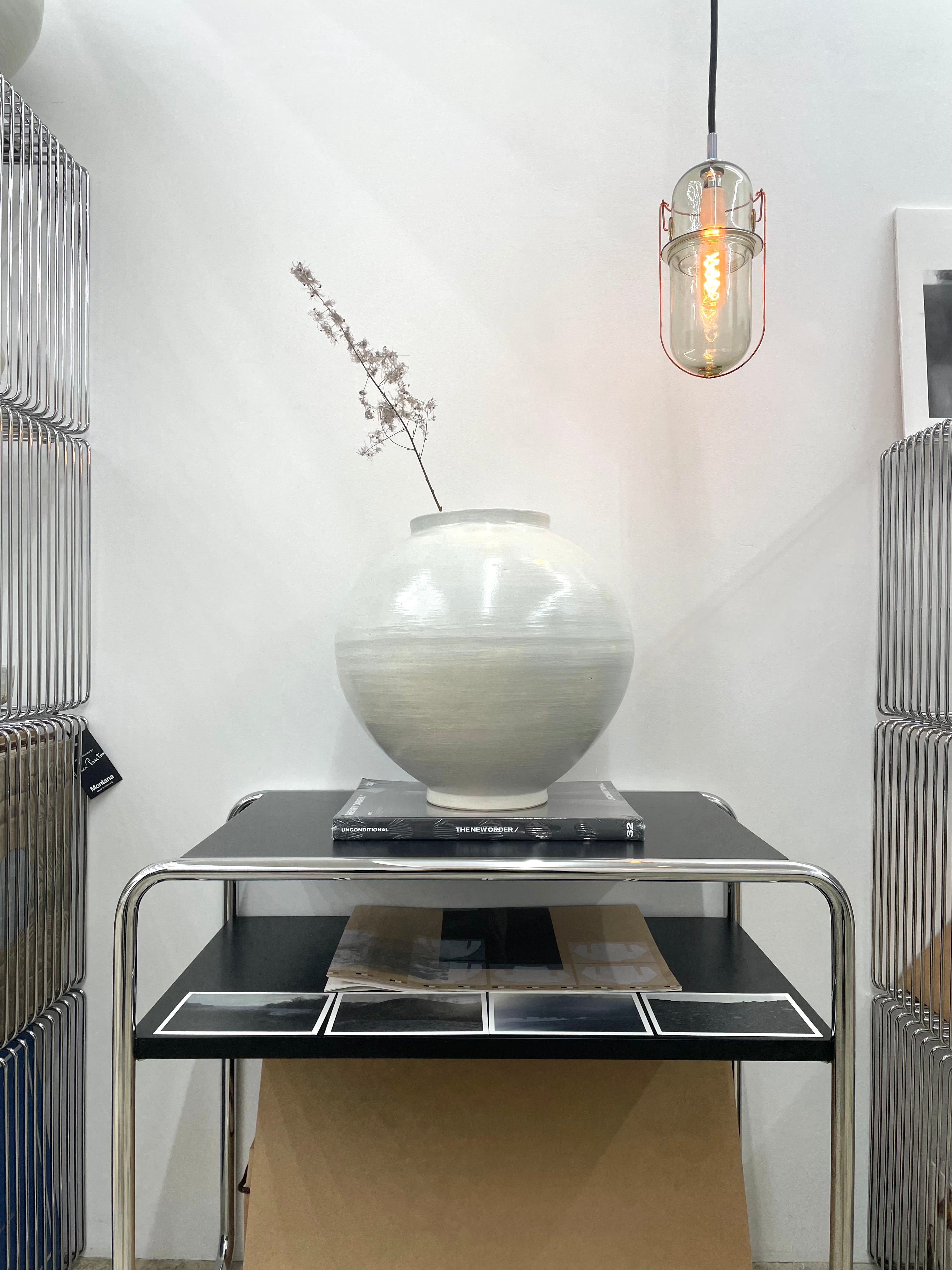
승평요(昇平窯) 달 항아리 10월
승평요의 달항아리는 한 해에 두 번에서 많아야 세 번밖에 불을 땔 수 없는 전통 장작가마에서 태어난다. 흙과 나무, 불길과 연기의 흔적이 스스로 새겨져 나오기에, 그 어떤 항아리도 같은 얼굴을 가질 수 없다.
피터캣에서는 이 달항아리를 매달 단 한 점씩 공개한다. 한 달 동안 인연을 기다리다가, 그 달이 지나면 다시는 판매되지 않고 영구 소장용으로 남게 된다.
10월의 항아리는 새로 지은 가마에서 처음 태어난 작품이다. 9월의 항아리와 달리 10월의 경우 유약이 조금 덜 발라져 매트한 질감과 군데군데 은은하게 보이는 모미지(일본어 ‘紅葉’에서 온 표현으로, 장작가마 소성 중 재와 불길, 점토 속 철분이 반응해 표면에 생기는 붉고 황금빛의 반점·그라데이션을 뜻한다)가 일품이다.
이번 작품은 한국에서 채취한 백색 발색 점토를 사용하고, 반건조 상태의 반구형을 접합하는 전통적 성형기법인 ‘업다지’ 방식을 통해 성형되었다. 그 결과 더욱 비대칭적이고 자연스러운 곡선을 지니게 되었다. 표면은 한국에서 얻을 수 있는 광물인 도석을 주로 활용하여 빛의 반사를 최소화하고, 재료 본연의 질감을 최대한 살렸다. 전체적인 형태와 색감은 화려함을 지양하면서도, 옛스러운 정취와 담백한 아름다움을 담고 있다.
勝平窯の月壺は、一年に二回から多くても三回しか火を焚かない伝統的な薪窯で生まれる。土と木、炎と煙の痕跡が自ずと刻まれるため、同じ顔を持つ壺は一つとして存在しない。
ピーターキャットではこの月壺を毎月一つだけ公開する。その月の間に縁を待ち、月が変われば二度と販売されず、永久所蔵用として残される。
十月の壺は、新しく築かれた窯で初めて生まれた作品である。九月の壺とは異なり、十月のものは釉薬がやや少なく施され、マットな質感とともに、所々に淡く現れるモミジ(日本語の「紅葉」に由来し、薪窯焼成中に灰や炎、土中の鉄分が反応して生じる赤や金色の斑点やグラデーションを指す)が魅力である。
今回の作品は韓国で採取された白色発色の粘土を使用し、半乾き状態の半球を接合する伝統的な成形技法「オプダジ」によって成形された。その結果、より非対称で自然な曲線を備えるようになった。表面は韓国で得られる鉱物である陶石を主に用い、光の反射を最小限に抑え、素材本来の質感を最大限に活かしている。全体の形と色合いは華美さを避けつつ、古風な趣と素朴な美を宿している。
The moon jars of Seungpyeongyo are born in a traditional wood-fired kiln that can only be fired two to three times a year at most. Traces of clay, wood, flame, and smoke imprint themselves naturally, ensuring that no two jars ever share the same face.
At Peter Cat, only one moon jar is unveiled each month. It waits for its encounter during that month, and once the month passes, it is never sold again and remains as part of a permanent collection.
The jar for October is the very first to be born in the newly rebuilt kiln. Unlike the September jar, the October piece has a thinner application of glaze, giving it a matte texture and adorned with subtle momiji (a term derived from the Japanese word for “autumn foliage,” referring to the reddish and golden spots and gradients formed during wood firing as ash, flames, and the iron in the clay react on the surface).
This work was shaped using white-firing clay sourced in Korea, employing the traditional up-daji method of joining two semi-dry hemispheres. As a result, it carries a more asymmetrical and natural curve. The surface was finished mainly with doseok, a mineral found in Korea, to minimize reflection and preserve the raw texture of the material. The overall form and tone avoid ostentation, instead embodying a nostalgic simplicity and restrained beauty.
Made in Korea
Material
Handcrafted White Porcelain
Purchase: In store only


